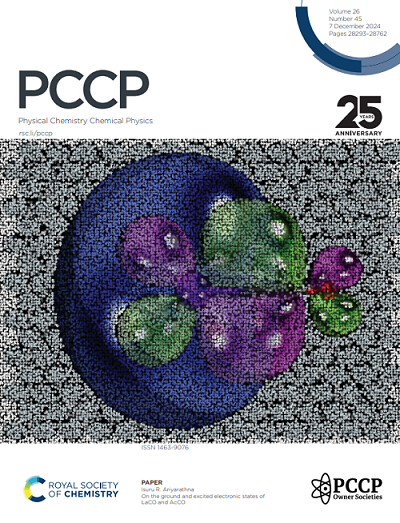On the Stability Constants of Metal-Nitrate Complexes in Aqueous Solutions
IF 2.9
3区 化学
Q3 CHEMISTRY, PHYSICAL
引用次数: 0
Abstract
Stability constants of simple reactions involving addition of the NO3- ion to hydrated metal complexes, [M(H2O)x]n+ are calculated with a computational workflow developed using cloud computing resources. The computational workflow performs conformational searches for metal complexes at both low and high levels of theories in conjunction with a continuum solvation model (CSM). The low-level theory is mainly used for the initial conformational searches, which are complemented with high-level density functional theory conformational searches in the CSM framework to determine the coordination chemistry relevant for stability constant calculations. In this regard, the lowest energy conformations are found to obtain the reaction free energies for the addition of one NO3- to [M(H2O)x]n+ complexes, where M represents Fe(II), Fe(III), Sr(II), Ce(III), Ce(IV), and U(VI), respectively. Structural analysis of hundreds of optimized geometries at high-level theory reveals that NO3- coordinates with Fe(II) and Fe(III) in either a monodentate or bidentate manner. Interestingly, the lowest-energy conformations of Fe(II) metal-nitrate complexes exhibit monodentate or bidentate coordination with a coordination number of 6 while the bidentate seven-coordinated Fe(II) metal-nitrate complexes are approximately 2 kcal/mol higher in energy. Notably, for Fe(III) metal-nitrate complexes, the bidentate seven-coordinated configuration is more stable than the six-coordinated Fe(II) complexes (monodentate or bidentate) by a few thermal energy units. In contrast, Sr(II), Ce(III), Ce(IV), and U(VI) metal ions predominantly coordinate with NO3- in a bidentate manner, exhibiting typical coordination numbers of 7, 9, 9, and 5, respectively. Stability constants are accordingly calculated using linear free energy approaches to account for the systematic errors and good agreements are obtained between the calculated stability constants and the available experimental data.求助全文
约1分钟内获得全文
求助全文
来源期刊

Physical Chemistry Chemical Physics
化学-物理:原子、分子和化学物理
CiteScore
5.50
自引率
9.10%
发文量
2675
审稿时长
2.0 months
期刊介绍:
Physical Chemistry Chemical Physics (PCCP) is an international journal co-owned by 19 physical chemistry and physics societies from around the world. This journal publishes original, cutting-edge research in physical chemistry, chemical physics and biophysical chemistry. To be suitable for publication in PCCP, articles must include significant innovation and/or insight into physical chemistry; this is the most important criterion that reviewers and Editors will judge against when evaluating submissions.
The journal has a broad scope and welcomes contributions spanning experiment, theory, computation and data science. Topical coverage includes spectroscopy, dynamics, kinetics, statistical mechanics, thermodynamics, electrochemistry, catalysis, surface science, quantum mechanics, quantum computing and machine learning. Interdisciplinary research areas such as polymers and soft matter, materials, nanoscience, energy, surfaces/interfaces, and biophysical chemistry are welcomed if they demonstrate significant innovation and/or insight into physical chemistry. Joined experimental/theoretical studies are particularly appreciated when complementary and based on up-to-date approaches.
 求助内容:
求助内容: 应助结果提醒方式:
应助结果提醒方式:


